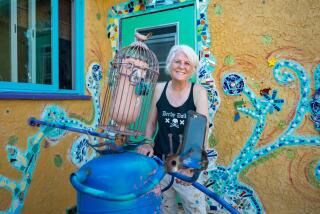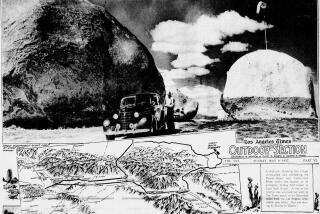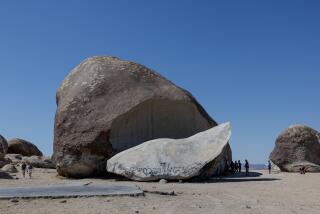With Tiananmen Square ‘Tank Man,’ Chinese sculptor will keep democracy’s flame alive in Mojave
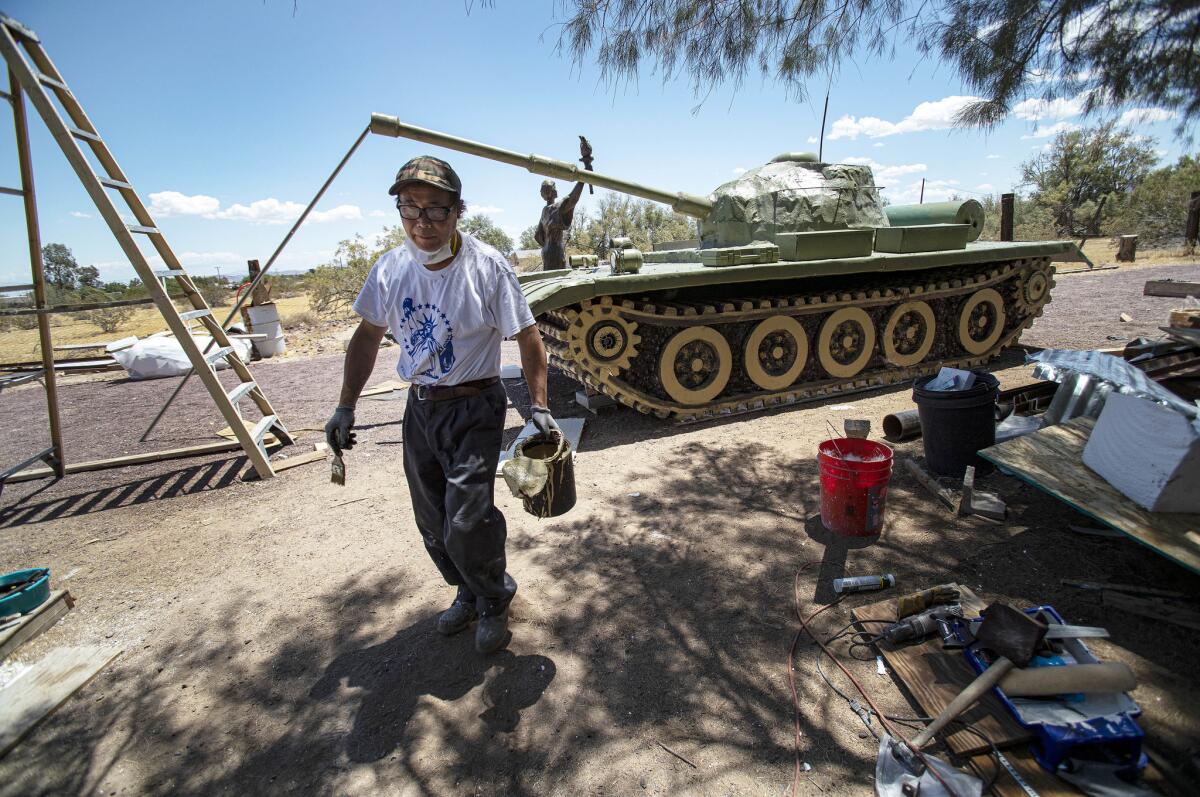
Reporting from Newberry Springs, Calif. — The 20-foot chrome head of Vladimir Lenin springs from the Mojave Desert.
Follow a driveway past a small cyan-colored lake ringed with palms and stocked with carp, past prefabricated homes and an artist shed made of 17 wooden doors nailed together, and there is Chen Weiming, fitting treads on a large replica of a military tank.
More than 120 miles east of the San Gabriel Valley, with its vast strip malls and temples and restaurants anchoring Southern California’s largest Chinese American community, the 62-year-old sculptor is building his tribute to “Tank Man,” the still unidentified man who in 1989 stared down a line of Chinese tanks during the Tiananmen Square crackdown.
Chen is among a group of Chinese dissidents using sculpture to draw attention to human rights abuses committed by the Chinese government and memorialize its victims.
They have staked their hopes in the California desert on a 36-acre plot along Interstate 15 large enough to meet their ambitions but cheap enough to accommodate their limited finances. The only Chinese characters in sight are a fleeting blur stamped on tour buses hurtling between Los Angeles and Las Vegas.
When Chen and his volunteers moved in three years ago, locals were skeptical and just a bit fearful, said Lise King, a Yermo resident who has helped Chen.
Lenin’s giant chrome head didn’t help.
“There was a lot of concern that communists were moving in,” King said.
Far from celebrating communism, Chen said he plans to enclose Lenin’s head with a cage to show that his doctrine is imprisoning.
The dissidents have named the plot Liberty Sculpture Park. Zhou Fengsuo, one of the student leaders at Tiananmen Square, envisions building a museum there and a 200-foot rendition of the Goddess of Liberty, the statue that protesters fashioned in the square from plaster, papier-mache and plastic foam 30 years ago.
The park is home to three sculptures so far: a bust of Crazy Horse; a statue of Li Wangyang, a Chinese dissident imprisoned for 21 years after the crackdown at Tiananmen; and the number 64, which represents the month and day when the Chinese government sent tanks and troops into Beijing’s central square.
Students and other protesters had gathered there for months to call for democratic reforms. The exact number of people killed when the government quashed the protests has never been determined, but estimates range from the hundreds to low thousands.
On Monday, the eve of the 30th anniversary of the crackdown, Chen will unveil “Tank Man.” He has built the man: 1,300 pounds of concrete, painted a deep bronze, briefcase in the left hand and a shirt in the other, staring ahead at where a tank should be.
But only two weeks before, Chen learned the tank he’d arranged to purchase from the United Kingdom for $30,000 — shipping not included — would arrive late, sometime in mid-July.
Unveiling “Tank Man” without the tank — the vanguard of a line of tanks that the mystery man had confronted in real life — was not an option for Chen. So he built one himself. With recycled steel, wood, fiberglass and plaster, he cobbled together an olive green replica tank. He used plastic foam for the treads, painted an inky purple.
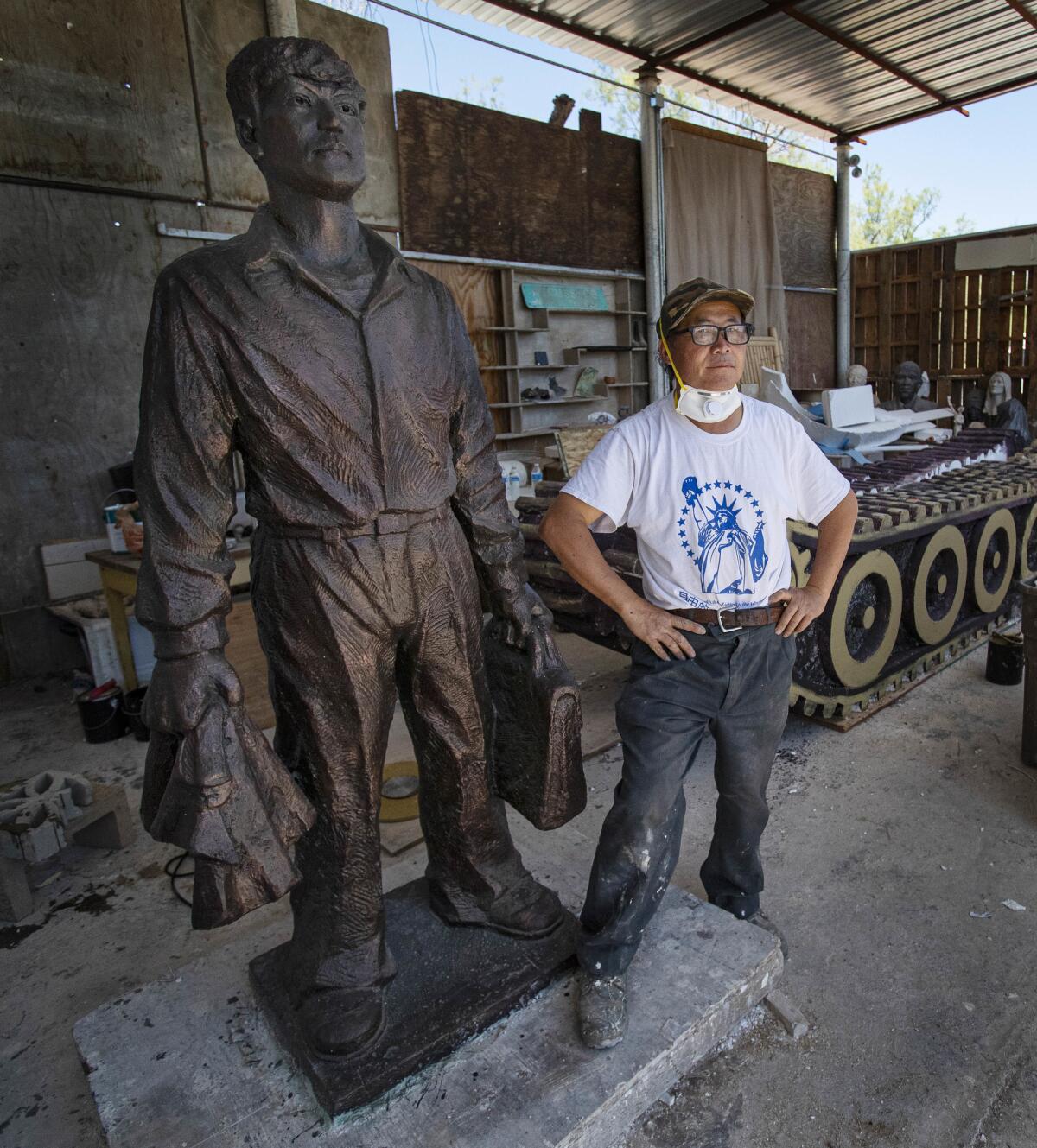
Chen, a Chinese native who holds New Zealand citizenship, purchased his artist compound in Newberry Springs, population roughly 3,000, three years ago for $300,000. For eight months out of the year, he builds sculptures for the desert park. During the other four months Chen works “for survival,” he says, making busts and statues that he sells.
He left China for New Zealand in 1988, one year before Tiananmen. He has created statues that stand in New Zealand, India and Hong Kong, including a replica of the Tiananmen Square protesters’ Goddess of Democracy that was confiscated in 2010 by Hong Kong police on the 21st anniversary of the crackdown.
Chen’s volunteers live on the property in prefab homes, a camper and stables on whose walls rusted riding gear still hangs. Chinese ballads are piped across the compound from a pair of massive, crackling speakers.
Some volunteers stay for a few days. Others, like Feng Wenyao, stay longer. Feng, 38, has spent the past month building a website for Liberty Sculpture Park.
Feng’s goal, he says, is to counter the stranglehold the Chinese government holds on information about Tiananmen Square. He was 8 years old when the crackdown happened. He heard about it first on an American radio channel. When he later heard the official government account, he knew “it’s not the truth.”
Feng left his hometown in southeast China 13 years ago. He believes China is less democratic than in 1989.
“Thirty years passed, and most people in China haven’t seen change,” he said.
Feng has spent a month at Chen’s desert compound. After seeing “Tank Man” unveiled, he will return to his job as a plumber in San Francisco.
Guo Jianlin, too, will return to his job and his family after the unveiling. Guo, 47, is from Beijing, where he works as an engineer. He has spent half a year in the desert.
Government officials in China know what he’s doing, he said. Through his wife, they have warned him. But Guo believes helping Chen build his sculptures is the best way he knows to tell the world what happened in Tiananmen Square.
“My own children, they don’t know,” Guo said.
Not all of the volunteers are Chinese or Chinese American. King helps Chen as a liaison to the surrounding community.
King was studying in Germany when the Chinese government suppressed the protests at Tiananmen Square and didn’t learn of it until she saw a poster of “Tank Man” several years later.
“I didn’t know what it was,” she recalled. “You see the man, you see the tanks, and you’re concerned. It telegraphs a sense of urgency.”
She hopes the image, in the form of a sculpture, will open the eyes of locals and motorists flying down I-15.
In Yermo, the interstate is like a conveyor belt of potential customers and converts. Chen’s statues come into view after billboards plugging Peggy Sue’s 50’s Diner; they are followed by 10 wooden signs delineating the Commandments and a prayer hotline.
“They say 75,000 people travel up and down that highway each day,” King said.
For Zhou, the student leader at Tiananmen Square, the traffic is a boon and the land was affordable. But the desert holds its own appeal.
“That’s where we are, in China’s pursuit of democracy,” he said. “For 30 years, we have kept the flame alive in the desert. It’s beautiful and wild and isolated, and that’s our situation.”
Zhou is now 51, the president of Humanitarian China, an advocacy organization. He is thinking about what the world will know of Tiananmen Square when those who witnessed it are gone.
Maybe the statues, on this forlorn stretch of earth along the highway, will make it harder to forget.
More to Read
Sign up for Essential California
The most important California stories and recommendations in your inbox every morning.
You may occasionally receive promotional content from the Los Angeles Times.
